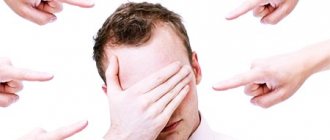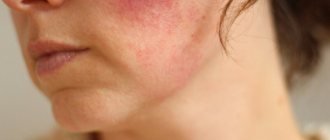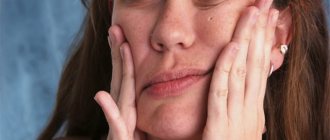Masked depression is one of the types of mental disorders that is subdepressive in nature. It is difficult to detect, because... it is always hidden under the symptoms of various diseases or addictions, and depression and bad mood are hardly noticeable. Knowing exactly what symptoms of masked depression may appear, as well as understanding all the main features of this disorder, helps in its timely identification.
Features and types
Latent depression is not included in a separate section of the International Classification of Diseases (ICD), but the sharp increase in the incidence of this disorder in people in recent years makes it one of the most common.
The main feature of such depression is the almost complete absence of signs of its development against the background of the appearance of mild symptoms from other body systems that could indicate any diseases. Latent depression can occur in two forms:
- Psychopathological. A person is always tired, depressed, lonely, anxious, he has no desire to rejoice or communicate with people, while he experiences a feeling of inferiority on the physical side.
- Psychosomatic. A person has a large number of complaints that are partly indicative of various diseases, but they are not enough to correspond to any specific disease. He may feel pain, tingling in his limbs, and have problems with sleep and sex life.
Based on the symptoms and characteristics of the disorder, it is customary to distinguish several variants of masked depression:
- Algic-senestopathic. The patient experiences unusual sensations throughout the body, accompanied by pain. They can concentrate in only one part of the body or move throughout all organs. The nature of the manifestation depends on the location.
- Agripnic. Characterized by sleep disorders. The person falls asleep poorly, his sleep is superficial and often interrupted. Often the patient wakes up very early, after which he can no longer fall asleep again. He has a sleepy state, there is no feeling of rest.
- Vegetative-visceral. It manifests itself in the form of VSD, which is accompanied by instability of blood pressure, pulse and respiration, as well as increased sweating with an increase in body temperature. Tenesmus, flatulence, and discomfort in the abdomen are common.
- Psychopathic. Characteristic of adolescence, but can sometimes appear in adolescence. The teenager is often lazy, he is not in the mood, he perceives any requests or demands with strong negativity, and does not experience any joy. Such behavior does not always mean that the child has masked depression of a neurotic nature. Often such actions of a teenager are age-related mental characteristics.
- Drug addict. It differs from others in its development against the background of alcoholism or drug addiction. Drinking alcohol or drugs is an unconscious attempt to overcome a subdepressive state.
- Asexual. Patients have no interest in the opposite sex, they do not experience positive emotions from communication. Women develop frigidity, while men experience impotence. When depression disappears, everything returns to its place without any help.
In rare cases, several types of hidden depression can be combined at once. This makes it much more difficult to find the root cause of certain symptoms.
When depression is detected, its masked form occurs in 20% of cases.
Causes
Most often, masked depression is found in women who spend a lot of time working. Moreover, the vast majority of patients are urban residents and have families. However, this is not a direct cause of the development of depressive disorders.
Sometimes depression is of a subordinate nature, i.e. appears after the manifestation of certain physical disorders. This makes its identification even more difficult, because Even many doctors are unaware of hidden depression that appears after minor violations.
The main causes of hidden depression are:
- Genetic predisposition;
- Taking certain medications;
- Hormonal imbalance;
- Pregnancy;
- Nervous tension;
- Serious stress.
As a rule, the cause of hidden depression is not of great importance, because... Treatment is aimed specifically at eliminating the disorder itself.
How to recognize the enemy?
I must immediately make a reservation that there are no clear criteria for diagnosing masked depression. It helps to establish a diagnosis that somatovegetative symptoms usually do not fit completely within the framework of the disease that they mimic, and doctors of non-psychiatric specialties, as a rule, notice this, and also pay attention to the failure of treatment of the suspected somatic disease.
The most difficult thing to detect is the actual disturbed mood. The doctor must be able to identify the various signs of depression present in the clinic of such an illness.
They suggest the idea of masked depression - the frequency of appearance of somatovegetative and mental disorders, the presence of a history of unclear somatic disorders, erased, classic depressive or manic phases, the suddenness of the onset and disappearance of attacks of the disease, the seasonal occurrence of attacks of the disease - mainly in the autumn-spring period, which is typical and other classic types of depression. Data on the lack of effect from somatic therapy and a positive reaction to treatment with antidepressants can be of great help in diagnosis.
Symptoms
Masked depression hides under certain “masks”, collecting symptoms of a separate category that are characteristic of a number of diseases. That is why doctors suspect the development of physiological diseases, and not a mental disorder. Signs of hidden depression can include several masks at once.
Mental pathologies:
- Paroxysmal anxiety, panic, appearance of phobias;
- Obsessive-compulsive disorders;
- Neurasthenic and hypochondriacal disorders.
Autonomic or somatization disorders:
- Dizziness;
- Neurocircular dystonia;
- Cardioneurosis;
- Neurodermatitis;
- Hyperventilation;
- Anorexia;
- Bulimia;
- Intestinal problems.
Painful manifestations:
- Neuralgia;
- Headache;
- Pain in the heart, stomach, spine;
- Polyarthralgia.
Sleep disorders:
- Insomnia;
- Severe drowsiness during the day;
- Nightmares;
- Hypersomnia.
Deviations in the social sphere:
- Lack of sexual desire;
- Formation of dependencies;
- Antisocial and hysterical behavior (touchiness, despondency, nervousness, conflict, aggression, etc.).
The depressive nature of such symptoms is suspected, as a rule, in cases where neurotic manifestations are pronounced.
Relatives of people suffering from hidden depression note a change in their behavior. Patients often feel resentful, become nervous and almost always depressed, and they tend to hide their symptoms from others, because they themselves are not aware of them.
Why are “saboteurs” dangerous?
In these states, the manifestations of depression are hidden behind a “façade” of various somatovegetative symptoms, so the doctor initially gets the impression that there is a somatic disease. Patients turn not to a psychiatrist, but to other specialists, are examined for a long time without success and treated in hospitals, where sometimes even serious interventions are undertaken. At the same time, doctors do not always pay attention to the low mood of patients, their statements about the severity of their physical condition and the failure of therapy, and in some cases about their reluctance to live. These complaints are often associated with the severity of the underlying disease. At the same time, the danger of suicide in masked depression, as in classic depression, is great.
Such patients are reluctant to go to psychiatrists even when there is a suspicion of a mental disorder. The period of treatment by various specialists can stretch for a long time, sometimes reaching 5–8 years, and the severity of depression usually increases. Suicidal attempts in general somatic hospitals are not uncommon, and a study of the medical histories of such suicides shows the presence of unrecognized, delayed depression. Medical staff and internists are often not prepared for such a turn of events, unlike psychiatric workers who are “always on guard.”
In some cases, psychiatrists cannot exclude the presence of a somatic illness, or they associate a depressed mood with the difficulty of diagnosing and treating a supposed “internal” illness.
Diagnostics
Masked depression in a person can only be treated after an accurate diagnosis has been made, which should be done by a specialist in the field of psychiatry. But when its course is hidden, the patient does not attach any importance to mental abnormalities, but instead concentrates on additional symptoms. For this reason, a person very often turns to a doctor of a completely different specialty, which corresponds to the symptomatic mask of depression. He may lose a lot of time while the doctor tries to make a diagnosis. In this case, the patient will hide all mental symptoms, because will consider them secondary and insignificant, and when asked about his well-being, he will answer that everything is fine, without reporting signs of depression.
In such cases, the doctor refers the patient to a psychotherapist. He, in turn, will begin to search for the real problem. All diagnostics consist of detailed interviews with the patient. Of particular importance are questions about:
- Well-being;
- Habits, interests, views;
- Plans for the future;
- Communication with others;
- Features of the work;
- Personal problems.
Very often the result is the identification of seriously low self-esteem, which has led to the development of negative views and hidden depression. This also explains the variety of symptoms that cause concern to the patient, because he considered them a sign of a dangerous disease.
The danger of hidden depression
Such patients, as a rule, visit an endless number of different specialists, presenting a lot of various complaints that can also occur with other somatic diseases. They undergo numerous studies that do not confirm either somatic or neurological diseases. These are patients who, despite months of examination by various specialists, do not have a definite diagnosis. They are often treated symptomatically, trying to relieve a specific symptom, but the treatment is ineffective, and patients continue to see doctors, and depression worsens, becomes protracted and more difficult to treat. Patients drop out of society, bring suffering to loved ones, lose their profession, friends, and skills. Due to the severity of depression, ideas of self-blame may arise in them, and suffering becomes unbearable. We may lose such a patient, since the suicide rate in depression is very high.
But, having reliable information and relevant knowledge, it is possible to diagnose masked depression in a timely manner. And if it is not quite pronounced and is caused by a psychologically traumatic situation, you can try to cope with the help of a psychologist or psychotherapist, take a vacation and try to relax where there is a lot of sun, relaxation and various amenities, take sedatives of plant origin, as well as those containing St. John's wort, which partially improves mood.
This is also not the end, even if the state of depression does not go away. There is always a way out! Seek help from doctors who are depression specialists. And it’s not scary that they are called psychiatrists, but they know what antidepressant you need to prescribe, in what dose and for how long.
They also know what to do to prevent depression from returning, and how to paint life in bright colors if that’s what you want!
We constantly detect plagiarism on our materials without providing a clickable follow link to them. In this case, without warning, we turn to Google DMCA , which leads to pessimization of the plagiarist. On the contrary, we welcome the popularization of our materials, but with the obligatory active follow link to this page psyhosoma.com/maskirovannaya-depressiya/ .
Treatment
After confirming the diagnosis, the attending physician will give recommendations on how to treat hidden depression. Successful treatment can only be achieved if the therapy is comprehensive. This approach is very important.
Treatment includes taking several types of medications and psychotherapy, which will help speed up the resolution of the problem and avoid possible difficulties during recovery. Features of therapy:
- Antidepressants. As a rule, Duloxetine or Anafranil is prescribed. If motor or mental function is impaired, Imipramine or Melipramine may be prescribed.
- Tranquilizers and nootropics. They help cope with severe anxiety, as well as improve the general condition of the nervous system. Most patients are prescribed Phenazepam, Phenibut or Afobazole.
- Sedatives. Special products can help you get rid of irritability, nervousness, aggressiveness, as well as improve heart function and improve the quality of sleep.
- Vitamins and minerals. Taking vitamin-mineral complexes helps maintain the nervous system in a normal state and reduce the negative effects of stress.
- Psychotherapy. The psychologist will teach the patient to easily understand himself, solve difficulties and get rid of negative thoughts. Special techniques can not only cure depressive conditions, but also completely change the patient’s life for the better.
The first positive changes after starting treatment will become noticeable within a couple of weeks. You will be able to completely get rid of latent depression in about a month. However, this is not a reason to stop treatment, because... there is a high risk of relapse. It is important to complete the entire course prescribed by your doctor. As a rule, it lasts from 3 to 6 months.
If masked depression is not treated, then there is a high probability of the addition of various mental pathologies, the elimination of which will require a lot of time and effort. But treating yourself without a doctor’s prescription is also not the right choice.
Folk remedies
For people who want to quickly improve their condition, there are folk remedies that allow you to treat depression at home. They can only be used if there are no contraindications to the use of any of the components present in the recipes.
How to deal with hidden depression at home:
- Fresh carrot juice. Use a juicer and pour the drink into a suitable container. Take 200 ml, adding a spoonful of honey, day and evening. The course of admission is 5 weeks.
- Ginseng tincture. Grind ginseng root (50 g), add vodka (500 ml), place in a dark place for a week, and then strain. Drink 25 drops before meals.
- Tincture of zest, cloves, lemon balm and nutmeg. Mix grated lemon zest, chopped cloves (1 g), lemon balm (10 g), nutmeg (3 g), pour vodka (1 l) over everything. Place in a dark place for a month, but shake every day. Drink daily, diluting 5 ml in a small amount of water.
With the help of such simple recipes, you can easily remove the symptoms of hidden depression and improve your condition. However, it is strictly not recommended to refuse drug treatment.










